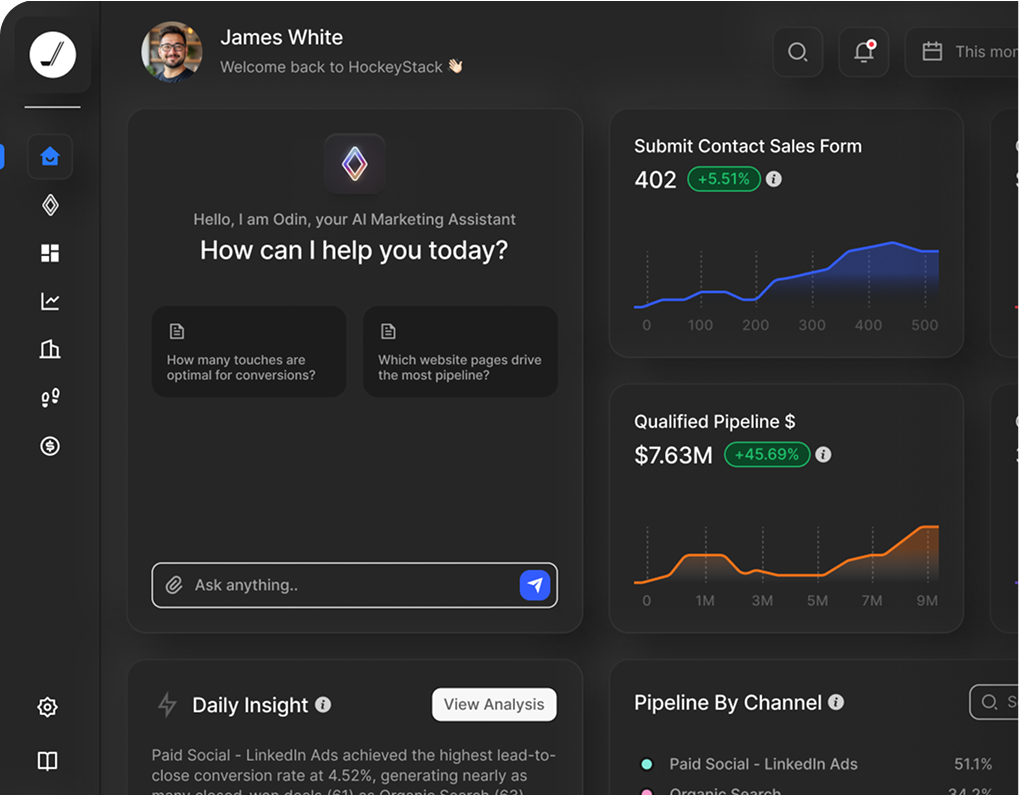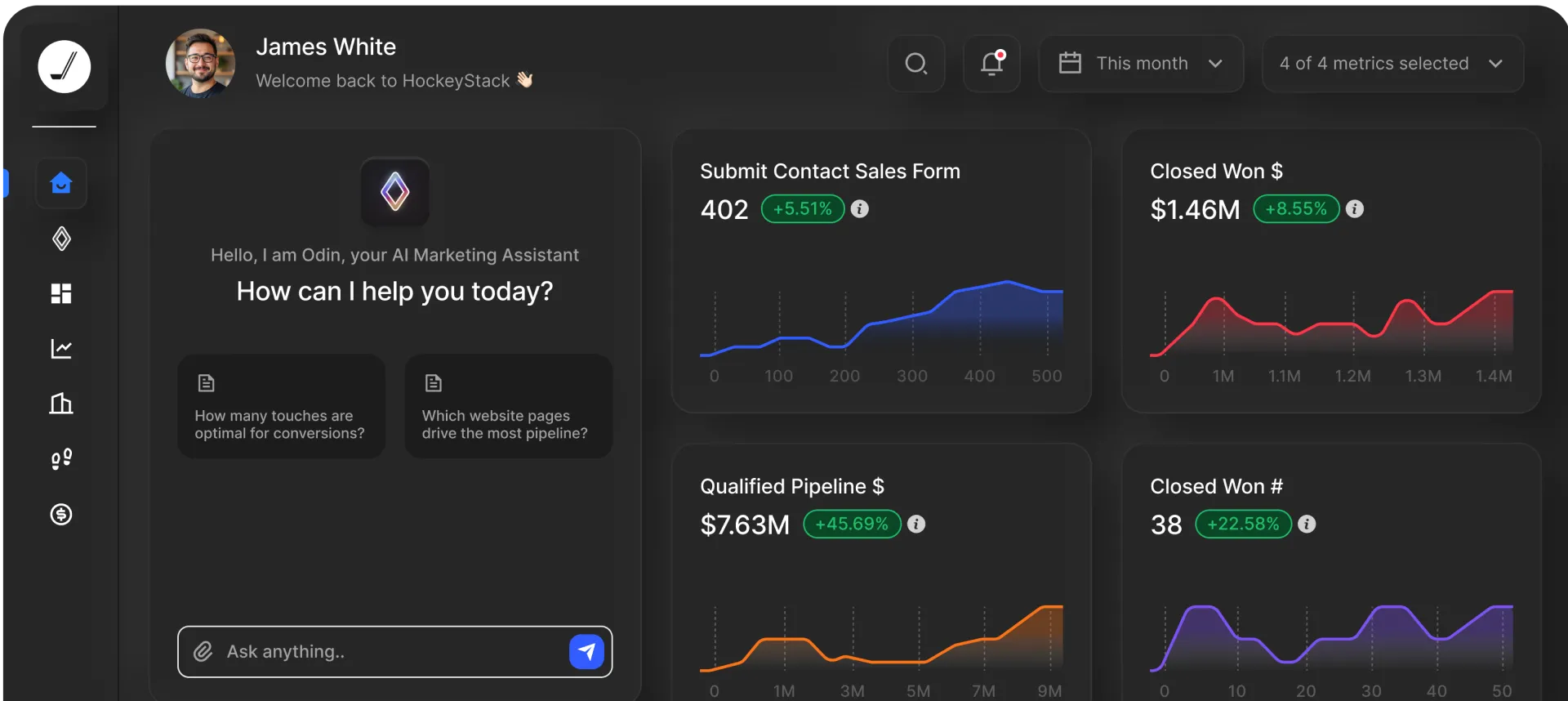Cognism Case Study

Cognism Case Study

Key Results
✔️ 5x Return on ad spend
✔️ 25% increase in their return on ad spend
✔️ 3 days saved every month since the team is not involved in reporting anymore
Cognism confronted numerous challenges in gauging the success of their demand generation strategy accurately. Despite LinkedIn being one of their primary platforms for outreach, they were unable to trace the journey from an impression to revenue on an individual ad or campaign basis. In addition, their use of Salesforce for tracking customer touchpoints offered limited visibility into the entire journey. These gaps in data left considerable ambiguity about the efficacy of their marketing efforts.
Furthermore, Cognism’s strategy incorporated both outbound and inbound deals. However, tracking marketing influence on outbound deals was a complex task. Finally, they lacked a seamless way to compare multiple data points across different channels. This landscape began to transform when Cognism adopted HockeyStack in January 2023.
Problem
LinkedIn impression to closed won – As a company doing demand generation and running reach campaigns, we were not able to measure the definite success of our demand generation strategy on the campaign level. With HS, we can track the impression>revenue journey on the campaign levels and ad levels. This helps us understand which ads and campaigns are contributing to the pipeline, even if our audience doesn’t click on an ad. With HockeyStack, we’re now able to optimize all of our ads toward revenue easily.
Salesforce data inaccuracy: we were only able to use Salesforce for the first touch or last touch, but we had no visibility on the whole journey. Now we can use multiple touchpoints to understand which channels contribute to which side of the journey. For example, for YouTube campaigns, we’re using linear attribution, but for LinkedIn campaigns, we’re using position-based attribution. By doing so, we can see the impact of each channel based on our channel strategy.
This is helping us measure the impact of Reddit and YouTube in scale.
Outbound/Inbound: In the past, we had inbound deals and outbound deals, but we were not able to track marketing influence in outbound deals. Now, we can see each marketing touch point in outbound deals. This way, even if a campaign or channel is not directly contributing to the inbound pipeline, we can see its influence on the general pipeline.
Outbound/Inbound: In the past, we had inbound deals and outbound deals, but we were not able to track marketing influence in outbound deals. Now, we can see each marketing touch point in outbound deals. This way, even if a campaign or channel is not directly contributing to the inbound pipeline, we can see its influence on the general pipeline.
Multiple data points and channels: with HockeyStack, we can compare multiple data points without any hassle. For example, we have one report that shows the spend, clicks, MQLs, pipeline, pipeline ROI, and CW possibility of the LinkedIn campaigns, Google ad groups, and Facebook campaigns together.
Approach
HockeyStack empowered Cognism to effectively track the journey from an impression to revenue at both campaign and ad levels. With this comprehensive data at their disposal, Cognism could discern which ads and campaigns were contributing to their pipeline, even if the audience didn’t engage directly via clicks. Consequently, this visibility allowed Cognism to optimize all their ads toward revenue more efficiently.
HockeyStack’s multi-touch attribution capabilities helped resolve Salesforce’s single-touch problem. It gave Cognism the ability to follow the complete journey of a prospect, from the first touch to the last. For instance, they adopted a linear attribution for YouTube campaigns and position-based attribution for LinkedIn campaigns, thus enabling them to understand how each channel contributes to different stages of the customer journey.
The tool also facilitated Cognism in measuring the impact of different channels like Reddit and YouTube at scale.
Results
A significant transformation was noted in how Cognism managed outbound and inbound deals.
HockeyStack allowed them to track each marketing touchpoint in the outbound deals. This way, even if a campaign or channel didn’t contribute directly to the inbound pipeline, its influence on the overall pipeline became visible.
HockeyStack also simplified the process of comparing multiple data points. It enabled Cognism to generate a single report encompassing spending, clicks, MQLs, pipeline, pipeline ROI, and the probability of closing won (CW) for their LinkedIn campaigns, Google Ad groups, and Facebook campaigns collectively.
AI Marketing Agents: Use Cases, Implementation, & Top Solutions
Looking to implement AI agents in your B2B marketing? This guide covers use cases, implementation strategies, popular agent reviews, and must-have features for 2025.


Ready to see HockeyStack in action?
HockeyStack turns all of your online and offline GTM data into visual buyer journeys and dashboards, AI-powered recommendations, and the industry’s best-performing account and lead scoring.

Ready to See HockeyStack in Action?
HockeyStack turns all of your online and offline GTM data into visual buyer journeys and dashboards, AI-powered recommendations, and the industry’s best-performing account and lead scoring.



